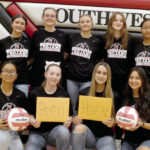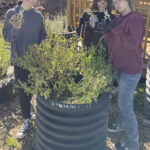Skip Easter: Caring for storm-damaged trees
Anyone that knows me will tell you I love trees and I’m addicted to trees.
I live in the middle of a forest of trees. When the first July windstorm struck this summer, my forest suffered many casualties.
Most of us in Barry County lost numerous tree limbs, entire treetops, and whole trees that were uprooted or broken anywhere from ground level up to 20 feet above the ground.
We are never ready to say goodbye to a tree that has been a major source of beauty or shade in our yard or forest. Sometimes, the tree can be pruned a little to remove the jagged, damaged rip site and will recover.
Sometimes, the amount of food producing limbs lost is too large for the tree to ever recover and it dies immediately or over the course of a few years. Sometimes, the partially ripped-off limbs are still weakly attached to the tree and become “widow makers” that will break off when we least expect it.
If you observe that parts of a tree are dangerously dangling where you or another person could be injured, that should take the highest priority, and you should act quickly to get the dangerous tree parts dropped to the ground. If they are directly above a picnic table, you can temporarily change the hazardous situation by moving the picnic table.
Stop parking your Corvette under that dangling branch until the danger is addressed.
A useful guide for handling storm damaged trees is the University of Missouri Extension publication G6867, First Aid for Storm Damaged Trees, by Hank Stelzer.
This covers most aspects of the decisions needed to determine if a tree will survive, if it can be pruned, and offers some guidance on how to properly prune a tree.
An uneven, jagged ripped stump offers lots of crevices and places for water to pool and hide and this leads to faster rotting. A smooth, angled straight cut sheds water.
If the cut is made at the outside edge of the branch bark collar against the main trunk or against the side of a main branch it will eventually seal over with callus tissue. Callus tissue is Mother Nature’s Band-Aid.
Cutting off the end of a branch will leave an open wound that never heals. No natural process exists that will seal the wound at a branch end. That’s why topping a tree is bad for tree health and shortens the lifespan of the tree.
Trees can be shaped without getting a wicked “tree topping,” but some tree trimmers don’t have enough training to understand how to do this properly.
A tree trimming professional does not need special tree pruning skills to remove a tree. They simply need good equipment, safe work practices, and insurance should they accidentally drop a tree on your home or car or sustain injuries on the job.
An Arborist certified by the International Society of Arboriculture might be in order if your tree needs some major corrective pruning. A Certified Arborist has attained a great deal of tree care knowledge through training and continuing education. More arborists are certified every year in southwest Missouri.
To locate an arborist, go the www.isa-arbor. com and click on For the Public followed by Find an Arborist. You insert the city and state to locate a person.
What trees are good to replace large shade trees that aren’t going to survive the storm damage? Some of my personal favorites are swamp white oak, shumard oak, northern red oak, southern red oak, pin oak, Kentucky coffeetree and bald cypress.
If you need to plant a tree that doesn’t get so large consider Chinese pistache (yellow leaves), redbud, native smoke tree, or one of the red maple cultivars like Autumn Flame or Autumn Blaze.
Fast-growing trees like silver maple and tulip tree can produce shade faster than many species but their fast growth produces more brittle wood that can break during storms. Plant them much farther away from the house!
Some of our more beautiful trees are very slow growing like sugar maple and the hickories.
I prefer to plant smaller container trees and put them on drip irrigation for a few years. The results are astounding. In 2008, I designed a major planting of 250 container trees that were planted in Monett’s South Park and North Park.
These were 3-gallon container trees ($13.95 at the time) that had stems as big as my finger. Volunteer boy scouts and science club students and I did the planting with hardwood mulch and an original watering by Monett Park staff.
Today, these trees are 20-25 feet tall and very healthy. You don’t have to break the bank to put trees back into your yard. But it does help during the initial establishment years to water during the dry spells in summer. Keeping a weed-free ring of mulch around the trees prevents damage to the stem by mowing equipment and weedeaters.
Just a little care for a lot of beauty.
Skip Easter is a forester with 44 years experience, certified arborist, member of the Barry County Master Gardeners and may be reached at treegal@sbcglobal. net.






